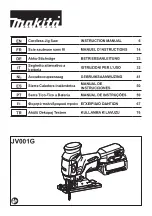
If the guard and the spring are not operating properly, they must be serviced
before use. Lower guard may operate sluggishly due to damaged parts, gum-
my deposits, or a buildup of debris. Disconnect the plug from power source.
Periodically remove the blade, clean the upper and lower guards and the hub
area with a degreaser and wipe it dry, or blow it clean with compressed air.
• The lower guard should be retracted manually only for making special cuts
such as “Pocket cuts” and “Compound Cuts”. Always raise lower guard by
lower guard handle lever. As soon as blade enters the material, the lower
guard must be released for all other sawing. The lower guard should operate
automatically.
• Always observe that the lower guard is covering the blade before placing
saw down on a bench or floor. An unprotected, moving blade will cause the
saw to jump, cutting whatever is in its path. Be aware of the time it takes for
the blade to stop after switch is released.
• NEVER hold the piece being cut in your hands or across your leg. It is im-
portant to support the material properly to minimize body exposure, blade
jamming, or loss of control.
• Always hold tool by the insulated gripping surfaces when performing an
operation where the cutting tool may contact hidden wiring or its own cord.
Contact with a “live” wire will also make exposed metal parts of the tool
“live” and shock the operator.
• DO NOT use any blades other than the DUALSAW Blades specially designed
for this tool. Other blades do not match the mounting hardware & will cause
loss of control.
• Never use damaged or incorrect flanges (drivers) or bolts. The flanges (driv-
ers) & bolts are specially designed for your saw for optimum performance
and safety of operation.
• DO NOT turn the saw on while carrying it. Lower guard may be opened by
contact with your clothing. Accidental contact with the spinning saw blade
could result in serious personal injury.
• Never attempt to operate saw with only one blade. Kickback will occur
and send the saw towards you resulting in serious injury.
HOW TO AVOID KICKBACK
Kickback is a sudden reaction to a pinched, bound or misaligned saw blade,
causing an uncontrolled saw to lift up and out of the work piece and toward
operator.
When the blade is pinched or bound tightly by the kerf closing down, the
blade stalls and the motor reaction drives the unit rapidly back toward the
operator.
SPECIFIC SAFETY RULES
6
Summary of Contents for M1YT-ZTH-115
Page 22: ...PART LIST 22...







































